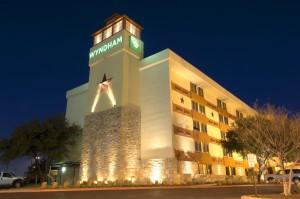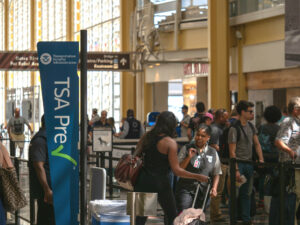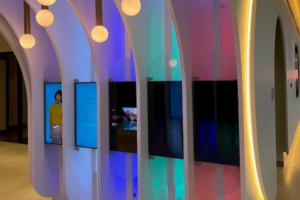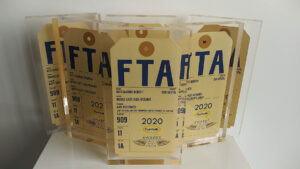Last edit by: serpens
What is EMV?
EMV is a standard for smart (or integrated-circuit, or chip) cards and the devices that can accept them. The standards are maintained by EMVCo and based on ISO 7816 (or ISO 14443 for contactless).
These cards come in two flavours: contact and contactless. Examples below:

----------------------------------------------------------
Notice the contactless
 indicator on the right-hand side (it looks like a sideways Wi-Fi symbol). It may also be found on the back of the card (for example, on the back of the new Costco credit card).
indicator on the right-hand side (it looks like a sideways Wi-Fi symbol). It may also be found on the back of the card (for example, on the back of the new Costco credit card).Where can I get a chip card?
Hawaiian717 operates a website with crowd-sourced information about various cards. You can adjust the search parameters to see cards with contactless, have PIN-primary authentication, etc.
Which businesses accept chip cards?
tmiw operates a website, also primarily crowd-sourced, that tracks chip-enabled merchants on a map. You can see if a merchant supports PIN, contactless, Quick Chip, et al.
Why doesn't my chip card ask for a PIN?
This is likely because you have a signature-preferring card. At this time, PIN-preferring cards issued in the US are rare. Not many financial institutions offer them; most of them instead provide Chip-and-Signature cards, which are programmed to prefer signature over PIN, if the card supports PIN at all.
What is the difference between Chip-and-Signature and Chip-and-PIN?
To the cardholder, the only major difference is how they authenticate themselves at the point of sale. The cardholder inserts their card as normal; instead of signing a screen or receipt, they will be asked to enter their PIN on the keypad.
[spoiler]
A few financial institutions issue some form of Chip-and-PIN credit cards or prepaid cards. Prepaid EMV cards however are not recommended due to junk fees.
Why no PIN? (cont.)
American debit cards are unique because they are psuedo-PIN-preferring cards. which may work at many automated kiosks. However, bear in mind the word may is used above is a context where there is no absolute certainty of success for certain environments such as automated kiosks due to different natures of offline and online transactions.
What is the difference between Chip-and-Signature and Chip-and-PIN? (cont.)
Most cards issued in the US are programmed to prefer signature, so save very few instances, they will prompt for a signature (unless the merchant sets a signature waiver). A PIN may be necessary in countries with mostly PIN-preferring cards when using unattended terminals (such as pay-at-the-pump or mass transit). If the card has a PIN for backup verification or ATMs, then that PIN should work. Otherwise, the card will be rejected. If the card is rejected, then either a.) the transaction must be performed by an attendant or b.) an alternative payment method will be required.
Some credit union issued credit cards will have this CVM (Cardholder Verification Method) as secondary if Chip-and-Signature cannot be done. Chip-and-PIN is the more prevalent method of authentication used outside the US, especially in transaction environments where no human interaction is needed (i.e. automated gas pumps, toll roads, train kiosks, etc.).
One chip can hold a lot more data, therefore it is capable of doing multiple verification methods. That's one of the great things about EMV over the mag-stripe which can hold very little data.
I want to know for sure what my EMV chip does. Is there anyway I can test out my own EMV card to see what the CVM list is?
alexmt has written up a nice step-by-step procedure on Post #3615.
If most of the EMV cards in the US is the Chip-and-Signature type, doesn't that mean it's still useless abroad?
Depends if you see it as glass half empty or glass half full. See Post #3 for further details on how Chip-and-Signature has worked both successfully and unsuccessfully depending on the merchant transaction environment and use your best judgment whether which one is right for you.
I don't want a chip in my card. I heard horror stories all over the media saying hackers can steal my credit card info from a mile away.
There are two types of chips. One is contactless and the other is contact. Cards can be either one or the other, or both.
In the Google Docs spreadsheet, the cards that are capable of contactless payments are listed seperately under the "RFID or NFC contactless chip" column. If it says yes, then that means it has the ability to do contactless payments. If it says no, it doesn't have that feature.
The one that the media has overhyped about hackers "stealing your information wirelessly" was the contactless type like this:
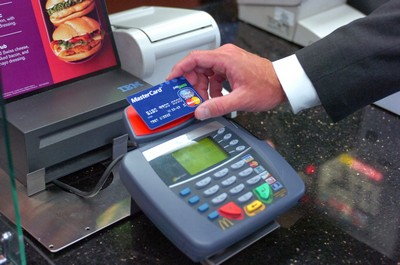
You are worried about this happening, right?
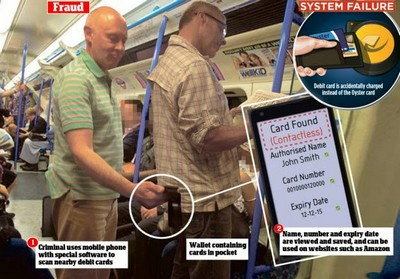
You don't have to worry. EMV is a chip standard that can have both contact and contactless interfaces. With the traditional contact interface, this means you actually have to physically insert the chip into a POS terminal for it to be authorized, like this:
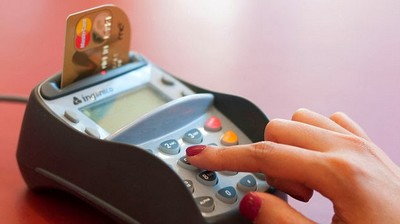
With the contact interface, nothing is wireless. No data is sent out in a stand-alone contact type EMV chip. With the EMV contactless interface, data is sent wirelessly.
Furthermore, contactless chip cards are required to show a symbol (looks like Wi-Fi symbol) somewhere on the card that to denote its capability as a contactless card. For example, here's an example of a Discover Card with contactless capability (in which Discover calls "Discover ZIP") showing the contactless symbol on the back of the card:
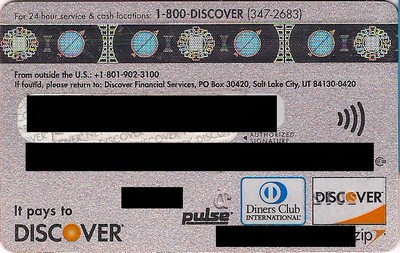
Don't believe everything that the media says. Besides, millions of people all over the world from London to Singapore, uses contactless payments daily in extremely crowded subways and mass transit with nary any problems. There are multiple layers of encrypted securities and keys that are needed to break the code.
Frankly, giving your physical card to a waiter/waitress who takes the card out of your view is much more susceptible to fraud than contactless payments.
Why should I care?
If you are an international traveler, you will want this because majority of the world has or in the process of converting to this payment format.
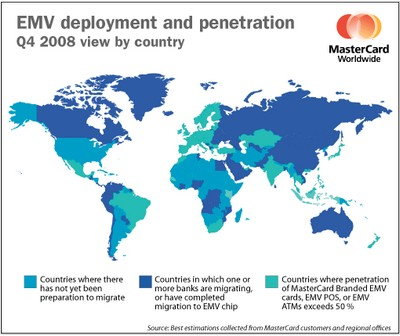
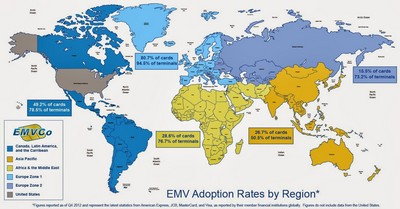
In fact, in 2012, even North Korea moved to the EMV format, leaving the US as one of the countries in the world that hasn't done so.
In addition, VISA, MC, AMEX, and Discover have all agreed to incentivize the USA shifting to EMV payments by 2015 by shifting liability for fraudulent transactions to merchants if they do not have EMV equipment and the cardholder has an EMV card. So if you travel internationally or would like to get one before the others, you might be interested in getting one.
BS! I had no problems using my card in [insert whereever country], [insert whatever point in time]
If you stick to the tourist path where they have lots of visitors from the US, you should have no problems using your mag-stripe only card in hotels and restaurants, at least for now. But as things can change as things go forward.
However, consider that once you start taking the off-beaten path, go to non-touristy places where they are not familiar with mag-stripes, rent a car and use toll roads, fill up gas, or try to buy train tickets you might end up into a trouble of the machine not recognizing your card because it lacks the chip. Furthermore, a lot of toll roads, gas pumps, and automated ticket machines lack any human assistance to help you when you need it the most.
But [insert credit card company] told me all merchants that display their logo must accept them! All I have to do is report them for violating their agreements, right?
There are several factors against this.
1. You can only speak English. The merchant representative, most likely a part-time clerk earning minimum wage, speaks in a different language, let's say French. If you have no French language skills, how are you going to get your point across? Are you going to whip out your cell phone at exorbitant int'l roaming charges and hope the customer service is going to translate it for you on the spot? Or maybe you might actually know French. But how about Swahili, Farsi, Balinese, or the multiple languages in mainland China?
2. Just like US, the rest of the world's businesses uses part-time minimum wage workers as cashiers to cut down on labor costs. Most of their SOP training manuals are written by MBA types to not to do anything they are not familiar with. Do not expect them to understand the intricate details of credit card mumbo jumbo. You don't expect Taco Bell employees to understand the minute details of Discover-JCB-Union Pay agreements, right? Same thing the other way around: be respectful as a guest in their country, prepare in advance in their ways, avoid being an "ugly American" stereotype.
3. You are a guest in their country. You are a minority. If 99.9% of their country's people and other tourists from around the world uses EMV, do you really think they are going to accomodate the 0.1% of American tourists who only have mag-stripes credit cards?
4. Again, you are a guest in their country. How would you, as an American standing in line, react if a Chinese tourist was clogging up the lines at a local Taco Bell because the clerk doesn't understand the Discover-Union Pay agreement and has trouble communicating between Mandarin spoken by the tourist and English spoken by the Taco Bell clerk? Same way the other way around. You do not want to clog up the lines for everyone. The less hassle, the better.
5. VISA and MC make tons of money from merchants in that country. Say SNCF French Rail. It's a billion dollar company in France. Do you think VISA is going to pull the plug of their relationship with SNCF because SNCF refuses to do mag-stripe processing at their unmanned train station kiosk? Of course not. Be realistic.
6. And lastly, if you're up against an unstaffed toll kiosk, gas pump or train ticket machine, are you going to yell curses at the machine?
But I want my credit card to be able to be used in the US too!
No worries. They have not gotten rid of the mag-stripe on the back of the card for backward compatibility reasons, just like we still have embossed numbers on our cards for backwards compatibility to using those old carbon copy imprinters.
[insert own Hyatt card image front and back together with red arrows pointing to all the backward compatibility features]
You use the chip on the front of the card abroad (for now), and the mag-stripe just like any other card for the US. Basically, you're increasing your credit card's acceptance rate by getting a card that both via the chip and the mag-stripe. You're getting a better deal for free.
And when 2015 comes along and US switches to EMV, you'll be way ahead of everyone else too!
So why did the rest of the world and the US moved/moving toward EMV?
Primarily, due to fraud concerns. You see, the mag-stripe has been with us since the 1950s. It may have been the most high tech thing back in the day, but with the technology that is available today, any shmo can pick up a $100 USB magnetic card skimming device off of eBay and get your credit card info.
And unlike skimming off contactless cards which actually need the person to have l33t programming skills, skimming off a magnetic stripe has become so ubiquitous that nary a day goes about skimming fraud going on somewhere in America, from gas pumps, Michael's stores (2011), Target breaches (2013), restaurant waiters/waitresses, to even McDonald's drive thrus.
https://www.google.com/search?q=skimming+fraud
These type of fraud used to be prevalent in Europe. But once they started switching over to EMV starting over 2 decades ago, this type of fraud went elsewhere. It went over to Asia, Canada and Mexico, Latin America, etc. etc. until they too began implementing EMV to combat skimming fraud. The US is practically the only country left that hasn't done so, therefore all the fraud that used to take place elsewhere is now happening here.
But EMV is old and it's not fool proof. Shouldn't we just skip over it and do something new instead?
Yes, EMV is old. It was developed in the 1990s, and its smart card payment predecessor was first introduced in France. But as of today, it has become the de-facto global standard of payments.
But then, what else is there? There is no other de facto global standard of payments alternative. For example, if we decide to skip over it and do something new, hypothetically like DNA matching technology, it still means US int'l travelers will continue to have problems abroad with useless plastic acceptance because no other country is using this DNA matching technology except the US.
Besides, nothing is fool proof. You can say that the bank vault isn't fool proof because you can crack it open if enough C4 is used. But your average low-life scumbag isn't likely to get military grade C4 easily either. But the bank vault does make it harder to get the bank's money over say a petty cash box. That's the point here. EMV is akin to a security tight bank vault, the old mag-stripe is akin to a petty cash box lying around inside the drawer.
I'm a business owner and I don't think EMV is going to take off. I'm not going to spend extra hundreds of dollars to upgrade my credit card machine. Convince me other wise why I should.
I can understand the added extra cost to your business once this switchover takes place. But before even saying that, look at your existing POS terminal. Does it have a slot somewhere to insert a card?
Most likely, if you had replaced your POS terminal within the past five years, you already have an EMV capable terminal. EMV is basically just not turned on yet from the processor and acquirer side.
If you have an EMV capable terminal, then a best bet would be to contact your acquirer to have the EMV feature turned on. You did your end of the deal already by having an EMV capable terminal, it is now the acquirers' responsibility to turn it on in accordance to the EMV switchover mandate.
And if you don't, you are going to replace your POS terminal anyway from common wear and tear. It isn't a hard switch-over. You can continue to use your POS terminal until it dies out because EMV cardholders will still have the mag-stripe on the back. And by the time your non-EMV capable POS terminal is up for replacement the market will be full with these newer POS terminals that can accept the mag-stripe, EMV, as well as contactless payments.
In addition, you may also want to check with your acquirer or processor about EMV capable terminals. Some of them are willing to replace your terminal for free in preparation for the US EMV switchover. Call and ask for details.
But what's in it for me? I'm the one that has to pay for the upgrade.
All the major card networks have given incentives for merchants for the upcoming EMV switchover.
If 75% or more of your credit card transactions are done on an EMV contact and contactless terminal, they are going to waive your annual PCI-DSS fees, which usually costs you around $5.00-$19.95/month per terminal. The overall long term cost savings of those compliance fees will be larger than the cost of an one time upgrade for the terminal.
The downside is that once EMV switchover happens and if you do not have a POS terminal that is able to accept EMV, the fraud liability shifts over to the merchant.
USA EMV cards: Availability, Q&A (Chip & PIN or Signature) [2017>]
#76
Join Date: Oct 2014
Programs: Skymiles
Posts: 3,251
Not to necessarily defend the banks' decisions on this but...
"I forgot my pin." (from a person whose pin is 5317 but keeps entering 5371).
People have three or four or more cards. Do they make the pins the same or do they have to memorize different pins? What about the infrastructure to change pins? Should pins be online or offline?
As I've said, and I want to be clear about it, had it been up to me I would have preferred chip and pin. But I do understand there are good reasons that make chip and signature more user friendly. I really do prefer the way we do things here with no cvm for small purchases and frankly value convenience more than the worry about fraud. At least for now, there is hardly any cloning being done on emv compliant cards. That is not to guarantee it won't happen in the future.
Let me ask you, as a consumer, why do you prefer pin if for no other reason than the slight chance, and it is slight thank goodness, there are a few places worldwide where the card lacking a pin may not be honored. As long (assuming you are from the United States) as your card works here, is it the possibility of fraud that makes you prefer pins? I will agree that I get po'd when I am in London and try to use a self service at a convenience store that I have to wait for a clerk to come over and get my signature for a 2 quid purchase but other than that, why should I care if the transaction goes through? The bottom line, of course, is not whether it is or isn't more convenient to us as consumers but the banks' studies that their losses due to fraud for lost or stolen cards is far less than the cost of converting to a pin infrastructure. Whether we like it or not, that remains the bottom line for the banks.
"I forgot my pin." (from a person whose pin is 5317 but keeps entering 5371).
People have three or four or more cards. Do they make the pins the same or do they have to memorize different pins? What about the infrastructure to change pins? Should pins be online or offline?
As I've said, and I want to be clear about it, had it been up to me I would have preferred chip and pin. But I do understand there are good reasons that make chip and signature more user friendly. I really do prefer the way we do things here with no cvm for small purchases and frankly value convenience more than the worry about fraud. At least for now, there is hardly any cloning being done on emv compliant cards. That is not to guarantee it won't happen in the future.
Let me ask you, as a consumer, why do you prefer pin if for no other reason than the slight chance, and it is slight thank goodness, there are a few places worldwide where the card lacking a pin may not be honored. As long (assuming you are from the United States) as your card works here, is it the possibility of fraud that makes you prefer pins? I will agree that I get po'd when I am in London and try to use a self service at a convenience store that I have to wait for a clerk to come over and get my signature for a 2 quid purchase but other than that, why should I care if the transaction goes through? The bottom line, of course, is not whether it is or isn't more convenient to us as consumers but the banks' studies that their losses due to fraud for lost or stolen cards is far less than the cost of converting to a pin infrastructure. Whether we like it or not, that remains the bottom line for the banks.
The availability to change PINs can be done with Issuer Scripts and the ability to choose between the two can also be done with issuer scripts (I have seen cards where you can reprogram the CVMs!)
Quick chip doesn't look like it'll be happening anyway since only one store uses it and every new EMV installation I see is still the good old regular one. Not Quick Chip
#77
Join Date: Jul 2007
Posts: 1,762
Well, there are many Americans who spend a considerable amount of time abroad. I think it's reasonable to expect that our credit cards will work efficiently wherever we go - that, after all, is the promise the banks and networks make.
But even if you never set foot outside the USA, there are a few answers to your question, "why do you prefer PIN." First, there's a psychological answer: studies show that people are quite willing to incur a cost just to punish a rule breaker or cheater, even if incurring that cost results in no direct benefit. There's probably an evolutionary reason for that, but just at a basic level, we don't like cheaters and lawbreakers. We all know that cloning magstripe credit cards is a huge criminal industry, and chip-and-pin offers the best protection (for now) against that. Chip-and-pin costs me nothing in convenience or money, so of course I'm in favor of it if it will prevent theft.
You could say, "who cares, it's the banks that lose to these criminals, not the customer," but of course the banks just pass the costs on to their customers (in the form of higher interest rates and/or less generous points offers). In the short term, yes, it's costing a lot to convert to PIN terminals, and yes, merchants are bearing a lot of that cost and it's mostly the banks who will benefit, but that's a different debate.
Finally, I actually don't think there is any inconvenience to the customer to be forced to convert entirely to chip-and-PIN - in fact, it's the opposite. In my experience, chip-and-PIN transactions actually go faster than signature. And being asked to remember a 4 digit PIN is hardly different from being asked to remember it for my ATM card - in fact, I can set them up so they have the same PIN.
But even if you never set foot outside the USA, there are a few answers to your question, "why do you prefer PIN." First, there's a psychological answer: studies show that people are quite willing to incur a cost just to punish a rule breaker or cheater, even if incurring that cost results in no direct benefit. There's probably an evolutionary reason for that, but just at a basic level, we don't like cheaters and lawbreakers. We all know that cloning magstripe credit cards is a huge criminal industry, and chip-and-pin offers the best protection (for now) against that. Chip-and-pin costs me nothing in convenience or money, so of course I'm in favor of it if it will prevent theft.
You could say, "who cares, it's the banks that lose to these criminals, not the customer," but of course the banks just pass the costs on to their customers (in the form of higher interest rates and/or less generous points offers). In the short term, yes, it's costing a lot to convert to PIN terminals, and yes, merchants are bearing a lot of that cost and it's mostly the banks who will benefit, but that's a different debate.
Finally, I actually don't think there is any inconvenience to the customer to be forced to convert entirely to chip-and-PIN - in fact, it's the opposite. In my experience, chip-and-PIN transactions actually go faster than signature. And being asked to remember a 4 digit PIN is hardly different from being asked to remember it for my ATM card - in fact, I can set them up so they have the same PIN.
I suppose we just have to agree to disagree. I do have a couple of pin preferred cards and I always take at least one of them when I am off to Europe but I hardly use them as my first choice. My first chice, of course as I am sue is yours, is the one giving me the best net rewards. Right now, that is a card with no ftf, no annual fee and the highest possible rewards. The fact it is signature preferred and actually does not come with a pin as far as I can see is no consequence. It is the card I reach for first. And I mutter to myself just as much when I have to forego its use as I say at self service checkouts in London just for convenience. But it is hardly an overwhelming problem.
The bottom line is the banks only care about their bottom line and I am sure they have done studies on this and have come to the conclusion that their losses due to lost or stolen chip compliant cards, which is the only time for now it matters, is less than the cost to implement a pin infrastructure. And for that reason, I would think, the adoption of pins in the USA is a long way down the track.
#78
FlyerTalk Evangelist
Join Date: Jan 2014
Location: San Diego, CA
Programs: GE, Marriott Platinum
Posts: 15,508
As I've said, and I want to be clear about it, had it been up to me I would have preferred chip and pin. But I do understand there are good reasons that make chip and signature more user friendly. I really do prefer the way we do things here with no cvm for small purchases and frankly value convenience more than the worry about fraud. At least for now, there is hardly any cloning being done on emv compliant cards. That is not to guarantee it won't happen in the future.
Granted, disabling PIN on terminals would at least help for (b), but that'd require the card networks and banks to make the chip and signature designation official for the US--something that they don't really want to do for some reason.
I believe Square made that reader specifically so that indie merchants would have a more economical option for chip and contactless, therefore being more likely to upgrade. Rather than spending $150 for the Miura, they only spend $50. It was even effectively free at one point.
But even if you never set foot outside the USA, there are a few answers to your question, "why do you prefer PIN." First, there's a psychological answer: studies show that people are quite willing to incur a cost just to punish a rule breaker or cheater, even if incurring that cost results in no direct benefit. There's probably an evolutionary reason for that, but just at a basic level, we don't like cheaters and lawbreakers. We all know that cloning magstripe credit cards is a huge criminal industry, and chip-and-pin offers the best protection (for now) against that. Chip-and-pin costs me nothing in convenience or money, so of course I'm in favor of it if it will prevent theft.
Assuming that happens, then it may result in a situation where debit cards are seen as "more" secure than credit cards. Debit cards already get way more use than credit cards and that impression could increase debit volume even further. The card networks and issuers may have to mandate PIN on credit to stem losses. (And/or maybe improve rewards earn even further?
 )
)Finally, I actually don't think there is any inconvenience to the customer to be forced to convert entirely to chip-and-PIN - in fact, it's the opposite. In my experience, chip-and-PIN transactions actually go faster than signature. And being asked to remember a 4 digit PIN is hardly different from being asked to remember it for my ATM card - in fact, I can set them up so they have the same PIN.
A lot of places also started their EMV upgrade/certification process way before Quick Chip was announced; they weren't going to stop the work they've already done just to incorporate that feature. I'd actually pay attention to what Costco does since Visa seems to be directly helping them with their EMV efforts, and quite possibly any fast food restaurant that hasn't already adopted EMV as well.
#79
Join Date: Aug 2005
Location: HPN
Programs: not anymore! I'm FREE!
Posts: 3,459
I suppose we just have to agree to disagree. I do have a couple of pin preferred cards and I always take at least one of them when I am off to Europe but I hardly use them as my first choice. My first chice, of course as I am sue is yours, is the one giving me the best net rewards. Right now, that is a card with no ftf, no annual fee and the highest possible rewards. The fact it is signature preferred and actually does not come with a pin as far as I can see is no consequence. It is the card I reach for first. And I mutter to myself just as much when I have to forego its use as I say at self service checkouts in London just for convenience. But it is hardly an overwhelming problem.
 . Of course I prefer to earn rewards, but it's actually gotten to the point where when I'm in Europe, I use my chip-and-PIN card for the majority of transactions, simply because it's faster, and I know I won't have to try again with another card, and (at less touristed places) salespeople won't fumble around trying to figure out how the signature thing works, saving me time.
. Of course I prefer to earn rewards, but it's actually gotten to the point where when I'm in Europe, I use my chip-and-PIN card for the majority of transactions, simply because it's faster, and I know I won't have to try again with another card, and (at less touristed places) salespeople won't fumble around trying to figure out how the signature thing works, saving me time.The problems solved by my chip-and-pin card are indeed not overwhelming, but FT is a forum for discussing travel-related minutia, not overwhelming world problems!
#80
FlyerTalk Evangelist
Join Date: Jan 2014
Location: San Diego, CA
Programs: GE, Marriott Platinum
Posts: 15,508
Actually we more or less agree  . Of course I prefer to earn rewards, but it's actually gotten to the point where when I'm in Europe, I use my chip-and-PIN card for the majority of transactions, simply because it's faster, and I know I won't have to try again with another card, and (at less touristed places) salespeople won't fumble around trying to figure out how the signature thing works, saving me time.
. Of course I prefer to earn rewards, but it's actually gotten to the point where when I'm in Europe, I use my chip-and-PIN card for the majority of transactions, simply because it's faster, and I know I won't have to try again with another card, and (at less touristed places) salespeople won't fumble around trying to figure out how the signature thing works, saving me time.
The problems solved by my chip-and-pin card are indeed not overwhelming, but FT is a forum for discussing travel-related minutia, not overwhelming world problems!
 . Of course I prefer to earn rewards, but it's actually gotten to the point where when I'm in Europe, I use my chip-and-PIN card for the majority of transactions, simply because it's faster, and I know I won't have to try again with another card, and (at less touristed places) salespeople won't fumble around trying to figure out how the signature thing works, saving me time.
. Of course I prefer to earn rewards, but it's actually gotten to the point where when I'm in Europe, I use my chip-and-PIN card for the majority of transactions, simply because it's faster, and I know I won't have to try again with another card, and (at less touristed places) salespeople won't fumble around trying to figure out how the signature thing works, saving me time.The problems solved by my chip-and-pin card are indeed not overwhelming, but FT is a forum for discussing travel-related minutia, not overwhelming world problems!

#81
FlyerTalk Evangelist
Join Date: Jan 2014
Location: San Diego, CA
Programs: GE, Marriott Platinum
Posts: 15,508
I just used my BofA Cash Rewards card for the first time in a long while to keep it active. Apparently it's old enough such that the Safeway/Vons system set byte 2 bit 8 of the TVR ("ICC and terminal have different application versions"). Definitely not something I've seen before but the transaction still went through.
Since the expiration is some time in 2017 I'll probably end up with the newer version of the card with online PIN being last on the CVM list. Not that I'm particularly looking forward to that since it'll make online PIN testing at unattended terminals more difficult.
Since the expiration is some time in 2017 I'll probably end up with the newer version of the card with online PIN being last on the CVM list. Not that I'm particularly looking forward to that since it'll make online PIN testing at unattended terminals more difficult.
#82
Join Date: May 2013
Posts: 54
Lacking Chip & PIN, for me, is a bigger problem than many think
Well said, although the claim that chip-and-signature is rarely problematic abroad is debatable. The Amsterdam public transit system and Netherlands rail system are hardly off the beaten track, but good luck trying to use a chip/sig card at their automats rather than standing in line to purchase at the counter.
#83
Join Date: Jul 2009
Location: SJC
Programs: AA, AS, Marriott
Posts: 6,066
I just returned from a trip to Europe and the Mid-East. When traveling, my preference is to use rewards cards giving 2X or 3X points, yet again, I encountered several instances where I couldn't use those preferred cards. Examples include: parking and gas stations in Belgium, train tickets in the Netherlands, vending machines in the UK and bus tickets and gas stations in Israel. Other earlier examples in include public transportation in Italy, gas stations in Germany, and so on. If there is a human being present, there is usually a work around, otherwise I've had to rely upon on 1X a rewards card that can handle such unattended transactions.
#84
Join Date: Jul 2009
Location: SJC
Programs: AA, AS, Marriott
Posts: 6,066
I saw a Japanese lady using a JCB card at Kate Spade in Waikiki last night. The cashier was asking her to insert the chip, but it resorted to fallback with her swiping the card. This is similar to the behavior of the ICBC UnionPay card at Target and Panera Bread.
I was curious if anywhere in the US runs things natively over either the JCB or UnionPay network, or if both are always processed over Discover? I didn't take my UnionPay card with me for this trip, so I can't do any test purchases. I'd imagine the chains would all operate the same as in the mainland, but perhaps some Hawaiian acquirers have the ability to accept JCB or UnionPay natively?
When I was in Italy, I saw some places advertise acceptance for UnionPay, but it was the more upscale places you would expect such as Mitsukoshi or Zegna.
I was curious if anywhere in the US runs things natively over either the JCB or UnionPay network, or if both are always processed over Discover? I didn't take my UnionPay card with me for this trip, so I can't do any test purchases. I'd imagine the chains would all operate the same as in the mainland, but perhaps some Hawaiian acquirers have the ability to accept JCB or UnionPay natively?
When I was in Italy, I saw some places advertise acceptance for UnionPay, but it was the more upscale places you would expect such as Mitsukoshi or Zegna.
#85
Join Date: Nov 2014
Location: NYC
Posts: 557
I'm fairly certain nobody in the US has the ability to accept JCB via EMV. The Marukai JCB thread is full of people complaining about chip acceptance problems.
#86
FlyerTalk Evangelist
Join Date: Jan 2014
Location: San Diego, CA
Programs: GE, Marriott Platinum
Posts: 15,508
Wait, I thought the US-issued JCB cards still don't have EMV? I only remember hearing about the chip not working for the ICBC UnionPay cards.
#87
Join Date: Nov 2014
Location: NYC
Posts: 557
Yeah, looks like I had that confused with a different thread on another board. The "Gold Card" by JCB is being issued with a chip (and the related complaints), but not the Marukai one. I can't tell if that's only ones issued overseas or if it's US ones as well.
#88
FlyerTalk Evangelist
Join Date: Jan 2014
Location: San Diego, CA
Programs: GE, Marriott Platinum
Posts: 15,508
Cheesecake Factory receipts look similar to the Ruby's Diner receipts but don't have EMV info. (I thought they had EMV?) They looked to have iPP320s attached to their POSes vs. the VX805s at Ruby's.
#89
Join Date: Oct 2015
Location: Northern Virginia
Posts: 1,592
You can either call your card issuer to ask about the transaction type or call the restaurant to ask if they have chip.
#90
FlyerTalk Evangelist
Join Date: Jan 2014
Location: San Diego, CA
Programs: GE, Marriott Platinum
Posts: 15,508
Eh, I somehow remembered someone here mentioning that they had EMV before, hence the question. I'd imagine the receipt would show the AID at the very least since it's a requirement.



